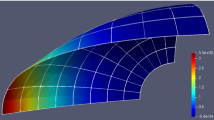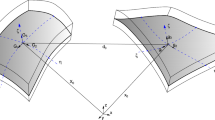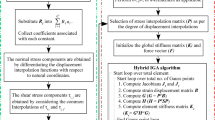Abstract
We propose a local type of B-bar formulation, addressing locking in degenerated Reissner–Mindlin shell formulation in the context of isogeometric analysis. Parasitic strain components are projected onto the physical space locally, i.e. at the element level, using a least-squares approach. The formulation allows the flexible utilization of basis functions of different orders as the projection bases. The introduced formulation is much cheaper computationally than the classical \(\bar{B}\) method. We show the numerical consistency of the scheme through numerical examples, moreover they show that the proposed formulation alleviates locking and yields good accuracy even for slenderness ratios of \(10^5\), and has the ability to capture deformations of thin shells using relatively coarse meshes. In addition it can be opined that the proposed method is less sensitive to locking with irregular meshes.




















Similar content being viewed by others
References
Hughes TJ, Cottrell JA, Bazilevs Y (2005) Isogeometric analysis: CAD, finite elements, NURBS, exact geometry and mesh refinement. Comput Methods Appl Mech Eng 194(39):4135–4195
Kagan P, Fischer A, Bar-Yoseph PZ (1998) New B-spline finite element approach for geometrical design and mechanical analysis. Int J Numer Methods Eng 41(3):435–458
Lipton S, Evans JA, Bazilevs Y, Elguedj T, Hughes TJ (2010) Robustness of isogeometric structural discretizations under severe mesh distortion. Comput Methods Appl Mech Eng 199(5):357–373
Marussig B, Zechner J, Beer G, Fries T-P (2015) Fast isogeometric boundary element method based on independent field approximation. Comput Methods Appl Mech Eng 284:458–488
Xu G, Atroshchenko E, Bordas S (2014) Geometry-independent field approximation for spline-based finite element methods. In: Proceedings of the 11th world congress in computational mechanics
Xu G, Atroshchenko E, Bordas S (2014) Geometry-independent field approximation for spline-based finite element methods. In: Proceedings of the 11th world congress in computational mechanics
Atroshchenko E, Xu G, Tomar S, Bordas S Weakening the tight coupling between geometry and simulation in isogeometric analysis: from sub-and super-geometric analysis to Geometry Independent Field approximaTion (GIFT), arXiv preprint arXiv:1706.06371
Toshniwal D, Speleers H, Hughes TJ (2017) Smooth cubic spline spaces on unstructured quadrilateral meshes with particular emphasis on extraordinary points geometric design and isogeometric analysis considerations. Comput Methods Appl Mech Eng 327:411–458
Kiendl J, Bletzinger K-U, Linhard J, Wüchner R (2009) Isogeometric shell analysis with Kirchhoff–Love elements. Comput Methods Appl Mech Eng 198(49):3902–3914
Benson D, Bazilevs Y, Hsu M-C, Hughes T (2011) A large deformation, rotation-free, isogeometric shell. Comput Methods Appl Mech Eng 200(13):1367–1378
Benson D, Bazilevs Y, Hsu M-C, Hughes T (2010) Isogeometric shell analysis: the Reissner–Mindlin shell. Comput Methods Appl Mech Eng 199(5):276–289
Benson D, Hartmann S, Bazilevs Y, Hsu M-C, Hughes T (2013) Blended isogeometric shells. Comput Methods Appl Mech Eng 255:133–146
Dornisch W, Klinkel S, Simeon B (2013) Isogeometric Reissner–Mindlin shell analysis with exactly calculated director vectors. Comput Methods Appl Mech Eng 253:491–504
Hosseini S, Remmers JJ, Verhoosel CV, Borst R (2013) An isogeometric solid-like shell element for nonlinear analysis. Int J Numer Methods Eng 95(3):238–256
Cottrell JA, Reali A, Bazilevs Y, Hughes TJ (2006) Isogeometric analysis of structural vibrations. Comput Methods Appl Mech Eng 195(41):5257–5296
Hu Q, Chouly F, Hu P, Cheng G, Bordas SP (2018) Skew-symmetric nitsche’s formulation in isogeometric analysis: Dirichlet and symmetry conditions, patch coupling and frictionless contact. Comput Methods Appl Mech Eng 341:188–220
Kiendl J, Bazilevs Y, Hsu M-C, Wüchner R, Bletzinger K-U (2010) The bending strip method for isogeometric analysis of Kirchhoff-Love shell structures comprised of multiple patches. Comput Methods Appl Mech Eng 199(37):2403–2416
Echter R, Bischoff M (2010) Numerical efficiency, locking and unlocking of NURBS finite elements. Comput Methods Appl Mech Eng 199(5):374–382
Hughes TJ, Cohen M, Haroun M (1978) Reduced and selective integration techniques in the finite element analysis of plates. Nucl Eng Des 46(1):203–222
Adam C, Bouabdallah S, Zarroug M, Maitournam H (2014) Improved numerical integration for locking treatment in isogeometric structural elements. Part I: Beams. Comput Methods Appl Mech Eng 279:1–28
Adam C, Bouabdallah S, Zarroug M, Maitournam H (2015) Improved numerical integration for locking treatment in isogeometric structural elements. Part II: plates and shells. Comput Methods Appl Mech Eng 284:106–137
Adam C, Bouabdallah S, Zarroug M, Maitournam H (2015) A reduced integration for Reissner–Mindlin non-linear shell analysis using T-splines. In: Isogeometric analysis and applications 2014, Springer, Berlin, pp 103–125
Elguedj T, Bazilevs Y, Calo VM, Hughes TJR (2008) B over-bar and F over-bar projection methods for nearly incompressible linear and non-linear elasticity and plasticity using higher-order nurbs elements. Comput Methods Appl Mech Eng 197(33–40):2732–2762
Bouclier R, Elguedj T, Combescure A (2012) Locking free isogeometric formulations of curved thick beams. Comput Methods Appl Mech Eng 245:144–162
Bouclier R, Elguedj T, Combescure A (2013) On the development of NURBS-based isogeometric solid shell elements: 2D problems and preliminary extension to 3D. Comput Mech 52(5):1085–1112
Bouclier R, Elguedj T, Combescure A (2013) Efficient isogeometric NURBS-based solid-shell elements: mixed formulation and B-bar method. Comput Methods Appl Mech Eng 267:86–110
Bouclier R, Elguedj T, Combescure A (2015) An isogeometric locking-free nurbs-based solid-shell element for geometrically nonlinear analysis. Int J Numer Methods Eng 101(10):774–808
Echter R, Oesterle B, Bischoff M (2013) A hierarchic family of isogeometric shell finite elements. Comput Methods Appl Mech Eng 254:170–180
Bletzinger K-U, Bischoff M, Ramm E (2000) A unified approach for shear-locking-free triangular and rectangular shell finite elements. Comput Struct 75(3):321–334
Brezzi F, Evans J, Hughes T, Marini L (2011) New quadrilateral plate elements based on Twist–Kirchhoff theory. Comput Methods Appl Mech Eng 200:2547–2561
Brezzi F, Marini LD (2013) Virtual element methods for plate bending problems. Comput Methods Appl Mech Eng 253:455–462
da Veiga LB, Lovadina C, Reali A (2012) Avoiding shear locking for the Timoshenko beam problem via isogeometric collocation methods. Comput Methods Appl Mech Eng 241:38–51
Auricchio F, da Veiga LB, Kiendl J, Lovadina C, Reali A (2013) Locking-free isogeometric collocation methods for spatial Timoshenko rods. Comput Methods Appl Mech Eng 263:113–126
Yin S, Hale JS, Yu T, Bui TQ, Bordas SP (2014) Isogeometric locking-free plate element: a simple first order shear deformation theory for functionally graded plates. Compos Struct 118:121–138
Kiendl J, Auricchio F, Hughes T, Reali A (2015) Single-variable formulations and isogeometric discretizations for shear deformable beams. Comput Methods Appl Mech Eng 284:988–1004
Beirão Da Veiga L, Hughes T, Kiendl J, Lovadina C, Niiranen J, Reali A, Speleers H (2015) A locking-free model for Reissner–Mindlin plates: analysis and isogeometric implementation via NURBS and triangular NURPS. Math Models Methods Appl Sci 25(08):1519–1551
Hu P, Hu Q, Xia Y (2016) Order reduction method for locking free isogeometric analysis of Timoshenko beams. Comput Methods Appl Mech Eng 308:1–22
Mitchell TJ, Govindjee S, Taylor RL (2011) A method for enforcement of Dirichlet boundary conditions in isogeometric analysis. In: Mueller-Hoeppe D, Loehnert S, Reese S (eds) Recent developments and innovative applications in computational mechanics. Springer, Berlin, pp 283–293
Govindjee S, Strain J, Mitchell TJ, Taylor RL (2012) Convergence of an efficient local least-squares fitting method for bases with compact support. Comput Methods Appl Mech Eng 213:84–92
Nguyen VP, Anitescu C, Bordas SP, Rabczuk T (2015) Isogeometric analysis: an overview and computer implementation aspects. Math Comput Simul 117:89–116
Simo J, Hughes T (1986) On the variational foundations of assumed strain methods. J Appl Mech 53(1):51–54
Antolin P, Bressan A, Buffa A, Sangalli G (2017) An isogeometric method for linear nearly-incompressible elasticity with local stress projection. Comput Methods Appl Mech Eng 316:694–719
Hughes TJR (1980) Generalization of selective integration procedures to anisotropic and nonlinear media. Int J Numer Methods Eng 15:1413–1418
Juettler B, Langer U, Mantzaflaris A, Moore S, Zulehner W (2014) Geometry + simulation modules: implementing isogeometric analysis. Proc Appl Math Mech 14(1):961–962
Macneal RH, Harder RL (1985) A proposed standard set of problems to test finite element accuracy. Finite Elem Anal Des 1(1):3–20
Bordas SP, Rabczuk T, Hung N-X, Nguyen VP, Natarajan S, Bog T, Hiep NV et al (2010) Strain smoothing in FEM and XFEM. Comput Struct 88(23):1419–1443
Chen L, Rabczuk T, Bordas SPA, Liu G, Zeng K, Kerfriden P (2012) Extended finite element method with edge-based strain smoothing (ESm-XFEM) for linear elastic crack growth. Comput Methods Appl Mech Eng 209:250–265
Surendran M, Natarajan S, Bordas S, Palani G (2017) Linear smoothed extended finite element method. arXiv preprint arXiv:1701.03997
Acknowledgements
Q. Hu is thankful for Prof. Gengdong Cheng for the valuable suggestions of this research subject. Y. Xia is funded by National Natural Science Foundation of China (Nos. 11702056, 61572021). Stéphane Bordas thanks partial funding for his time provided by the European Research Council Starting Independent Research Grant (ERC Stg grant agreement No. 279578) “RealTCut Towards real time multiscale simulation of cutting in non-linear materials with applications to surgical simulation and computer guided surgery”. We also thank the funding from the Luxembourg National Research Fund (INTER/MOBILITY/14/8813215/CBM/Bordas and INTER/FWO/15/10318764).
Author information
Authors and Affiliations
Corresponding author
Additional information
Publisher's Note
Springer Nature remains neutral with regard to jurisdictional claims in published maps and institutional affiliations.
Appendices
Appendix A: Using an approximated normal vector field
In Eqs. 8 and 9, the normal vector field \(\varvec{n}(\xi ,\eta )\) should be commonly built as \(\sum R_A \varvec{n}_A\), where \(\varvec{n}_A\) needs to be specified for each control point: it denotes the normal vector of a mid-surface point associated with the control point \(\varvec{x}_A\). Although no approximation error occurs, it is time-consuming to solve for the mid-surface projecting points of \(\varvec{x}_A\). In this paper the normal vectors at the Greville abscissae \((\tilde{\xi },\tilde{\eta })\) are adopted to construct a normal vector field approximately [21], the field is re-written as \(\sum R_A(\xi ,\eta )\tilde{\varvec{n}}_A\). Following Eq. 2, these normal vectors \(\tilde{\varvec{n}}_A\) at the Greville abscissae points can be easily calculated. Thus we have
and
Appendix B: Detailed formulation of degenerated Reissner–Mindlin shell element
In the following we introduce some necessary aspects to obtain the element stiffness matrix:
-
(a)
Using Voigt notation, the relation between the strain vector and the stress vector is expressed as
$$\begin{aligned} \varvec{\sigma } =\varvec{D}_g \pmb {\varepsilon }, \end{aligned}$$(B.1)
where \(\varvec{D}_g\) is the global constitutive matrix, and
here \(\varvec{D}_l\) is a given local constitutive matrix. To fulfill the plane stress state \(\sigma _{33}=0\), the local constitutive matrix is given by
in which \(\kappa \) is the shear correction factor and it is set to be 5/6 in this research. To fit the physical shape of the mid-surface, a transformation is employed for \(\varvec{D}_l\), specifically
At each Gauss quadrature point, vectors in Eqs. 2 and 3 are calculated, then the transformation in Eq. B.2 is performed.
-
(b)
Based on Eq. A.1, the Jacobi matrix is calculated by
then the physical gradient of the shape functions are
Moreover for \(\zeta \frac{h}{2}R_A:=\tilde{R}_A\), their physical gradients are given by
-
(c)
Taking a look at the strain formula Eq. 5, we form the strain matrix as
Finally the element stiffness matrix is calculated by
Rights and permissions
About this article
Cite this article
Hu, Q., Xia, Y., Natarajan, S. et al. Isogeometric analysis of thin Reissner–Mindlin shells: locking phenomena and B-bar method. Comput Mech 65, 1323–1341 (2020). https://doi.org/10.1007/s00466-020-01821-5
Received:
Accepted:
Published:
Issue Date:
DOI: https://doi.org/10.1007/s00466-020-01821-5




